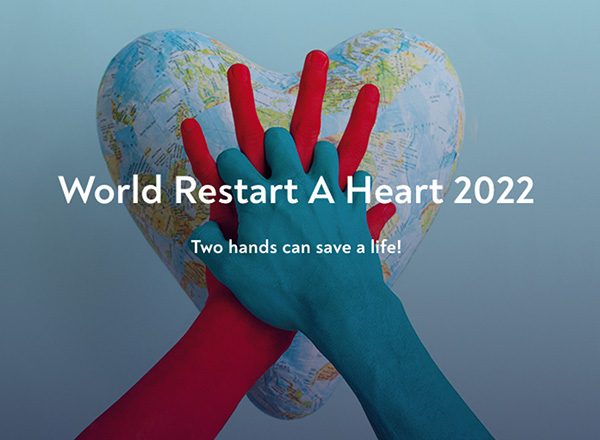Every year on October 16, resuscitation organizations around the world celebrate World Restart a Heart Day with the goal of improving survival from out-of-hospital cardiac arrest (OHCA). Survival rates of OHCA average less than 10%, although there's some evidence that they have increased. Improvement in survival rates has mostly happened in developed nations, but bystander CPR is the primary factor in increasing a person's odds of survival no matter where they live.
Recently, the Global Resuscitation Alliance held a webinar with speakers from the United Kingdom, Canada, and Singapore, followed by an expert panel with professionals from Taiwan and Australia. The webinar covered:
- Technological advances in public access defibrillation
- A free app-based CPR course to make training accessible to all
- Efforts to develop a prehospital emergency care toolkit that works for low- and middle-income countries (LMICs)
About the Global Resuscitation Alliance
The Global Resuscitation Alliance, working with other organizations, aims to increase awareness of CPR and improve systems of care in countries worldwide to support bystander resuscitation efforts. The group is made up of emergency medical service (EMS) leaders who aim to improve survival from cardiac arrest by 50%. Seattle and King County in Washington state have cardiac arrest survival rates of 62%, in accordance with the Utstein Formula for Survival, which employs three elements in hypothesizing potential survival rates: Medical Science, Educational Efficiency, and Local Implementation. Their experience led to the development of the Resuscitation Academy, which created 10 programs to provide a framework for improving cardiac arrest survival in communities and nations, and it forms the basis of the Alliance's agenda. The Alliance hosts webinars throughout the year, the latest focused on World Restart a Heart Day. This initiative focuses on two messages: "All citizens of the world can save a life" and "You only need two hands." Here are some highlights:
Next-Generation Defibrillators to Improve Bystander Resuscitation
Steven Brooks, MD, MHSc, FRCP, an associate professor and emergency physician from Queen's University in Canada, talked about how technological advances are making it easier for the public to access and use defibrillators. He was part of an International Liaison Committee on Resuscitation panel to develop a statement about how to optimize OHCA survival with innovative approaches to public access defibrillation.
The statement looked at what prevents people from providing bystander support with automated external defibrillators (AEDs), education for kids in schools on how to use AEDs and how accessible AEDs are in public areas. AED accessibility and use vary by country and region, with some areas having registries to help people find AEDs through apps or crowdsourcing efforts.
Within this space, a lot of innovation is happening to help improve bystander resuscitation and support faster access to AEDs for EMS personnel. Brooks discussed some of the advances happening with AEDs. The primary focus of developments is to reduce the size and cost of AEDs to make it easier for individuals to have them as well as to place them in public locations.
Many of these newer AEDs have connectivity with emergency dispatch centers and are designed for home use. He focused on CellAED, a single-use defibrillator developed for simplicity. It has internet accessibility that can help monitor the device's status.
These lower-cost, portable AEDs create the opportunity to get defibrillators in the hands of more people.
Free, Accessible Bystander CPR Training
Estelle Stephenson from the British Heart Foundation discussed a digital CPR training tool to help laypeople learn CPR skills. The foundation developed RevivR — a free, 15-minute training program people can access on their phones. It focused on steps in the chain of survival including recognizing a cardiac arrest, calling emergency services, and providing chest compressions. It also teaches people how to use a defibrillator and where to find one.
The app simulates an emergency call and uses the phone's camera to capture chest compression movements and provide real-time feedback. The British Heart Foundation is working to get the app to students and employees in large corporations. They're continuing to scale the training tool to reach more people throughout the U.K.
Improve Prehospital Emergency Care in LMICs
Dr. Gayathri Devi Nadarajan of SingHealth Duke-NUS Global Health Institute spoke from Singapore about developing a toolkit to improve OHCA survival in developing nations. The 10 programs are often harder to implement in developing nations because the basic infrastructure these programs rely on isn't in place. For example, many existing frameworks focus on hospital emergency departments rather than prehospital emergency care systems.
She and colleagues have determined a need for an Asia-specific toolkit. The group is developing a consensus statement that will feature 10 elements that span the five links in the chain of survival. Each element will have key indicators used to measure implementation. The final Prehospital Emergency Care Systems Evaluation Toolkit for LMICs should be available in 2023.
Final Thoughts
After the presentations, Ann Doll, secretariat of the Global Resuscitation Alliance, held a discussion with Tony Walker, CEO of Ambulance Victoria in Australia, and Matthew Huei-Ming Ma, MD, of National Taiwan University Hospital.
Ma discussed Taiwan's efforts to have national AED registry and how newer devices with internet or cellular connectivity make it easier to create these registries and help people find defibrillators. He also talked about how Taiwan has a long history of providing CPR and AED training in schools as a standard part of the curriculum. Digital training opportunities are changing how the country approaches this learning, with an interest in combining compression and defibrillator training and placing educational kiosks in major gathering places to give the public easy accessibility.
Walker felt the benefit of RevivR was moving toward using technology to remove barriers to CPR training access. Coupling RevivR with high-quality telephone CPR from emergency responders has the potential to save lives.
Walker also noted how the toolkit being developed for LMICs could have applications in developing nations outside of Asia as well as in rural areas, which often have limited access to emergency responders and health care facilities. The toolkit has the potential for broad application to expand on the 10 programs and create more focus on methods of improving survival from OHCA.
The Global Resuscitation Alliance website features case studies with creative ways hospitals and health organizations have implemented the 10 programs around the world.
"With our valued partners, we implement programs that work," Doll said. "We're seeing results that are impressive. Accelerating community implementation of effective programs through a quality improvement strategy, a measure-and-improve strategy, absolutely leads to increased cardiac arrest survival."









